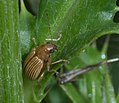| Colaspis brunnea | |
|---|---|
 | |
| Scientific classification | |
| Kingdom: | Animalia |
| Phylum: | Arthropoda |
| Class: | Insecta |
| Order: | Coleoptera |
| Suborder: | Polyphaga |
| Infraorder: | Cucujiformia |
| Family: | Chrysomelidae |
| Genus: | Colaspis |
| Species: | C. brunnea |
| Binomial name | |
| Colaspis brunnea (Fabricius, 1798) | |
| Synonyms | |
Colaspis brunnea, the grape colaspis, is a species of leaf beetle from North America. [1] [2] [3] It mainly occurs in the eastern United States. It is a pest of crop such as corn and soybeans, but damage by it has not been documented as economically significant. It is univoltine, and overwinters in the soil as larvae. [4]
Contents
The adults are brown-colored (brunnea is Latin for brown) and are around 5 mm in length. The elytra have a series of parallel rows of "puncture" marks. The larvae are scarabaeiform grub with white-grey bodies and orange head capsules, and are between 5 and 6.5 mm long at the 10th instar.
